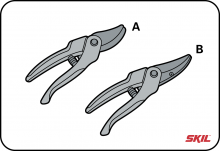-
Secateurs – the must-have tool for every gardener
No gardener can do without secateurs to prune thin and medium-thick stems. Secateurs come in two versions: bypass (parrot beak) secateurs and anvil secateurs.
Bypass secateurs (A)
Parrot-beak secateurs are equipped with two sharp blades that work like scissors. This type is very well suited to plants with soft and hollow stems.
Anvil secateurs (B)
Anvil secateurs consist of one sharp blade and a flat block. The stem rests against the flat block, with the blade coming down to cut it. The anvil type is very well suited to plants and bushes with wooden branches. The flat blade ensures that the stems are not pressed shut in the act of pruning.
You should make sure that your secateurs are always sharp. This will save you a lot of time and energy. Hardened steel blades stay sharp the longest, so they need less maintenance. -
Pruning saw – for thicker branches
A manual or electric pruning saw is the more practical solution for thicker branches. A pruning saw is also good when you need to prune in difficult-to-reach spots. Pruning saws come in various shapes and sizes, with or without replaceable saw blade. When choosing a manual pruning saw it’s important to check the teeth. Impulse-hardened teeth stay sharp longer; saws with hard-metal teeth stay sharp even longer.
The disadvantage of a manual saw is that you have to push down hard. An electric pruning saw is convenient when you need to saw thicker branches. You should maintain your tools well to ensure they stay sharp.
You could even use a reciprocating saw on thicker branches. -
Loppers – for harder, thicker branches
Like the pruning saw, loppers are designed for thicker branches. Loppers look a bit like secateurs, but with longer handgrips to allow you to exert more pressure and work above head height easily. You can often adjust the length of the handles. Loppers are ideal for cutting hard, thick branches, although they can also be used to cut branches for garden waste. -
Chainsaw – for thicker branches and tree trunks
A chainsaw is ideal for thicker branches and tree trunks. Both electric and petrol chainsaws are available. An electric chainsaw is lighter and more convenient for DIY jobs. Decide how you want to saw before you start to ensure you work as safely as possible.
The way you cut determines how the tree falls. Start by cutting a piece out on the side you want the tree to fall on. Now cut a piece out of the other side a little bit higher than the first. You can keep sawing on this side until the tree falls. For your own safety, power off your chainsaw as soon as the tree falls.
The saw may jam because the heavy weight of the tree rests on the saw cut. In that case, drive a wedge into the saw cut to free up the saw. -
Korak nasvet
Always use safety goggles, firm gloves, ear defenders and chunky clothing. A mask and a helmet will give you added protection against sawdust that sprays out at high speed. -
Hedge trimmer – modelling hedges and bushes
Hedge trimmers come in three different versions: manual, electric and petrol-powered. With a manual hedge trimmer you can keep trees, hedges and bushes in shape. An electric or petrol hedge trimmer is the ideal solution if you’d like to work faster. It can be used for bigger, heavier hedge pruning jobs. For your own safety, wear safety goggles and gloves when pruning with a hedge trimmer. -
Grass shears – easier to handle than a hedge trimmer
The best tool for the box is a box trimmer (or grass shears). Grass shears are a lot smaller than a hedge trimmer and are easier to handle, enabling you to trim the box into the right shape much more easily. Manual grass shears are available for light pruning jobs. If you have a bigger job on your hands or you want to make it easier for yourself electric grass shears are the ideal choice. -
Clearing away pruning waste with a leaf blower
A leaf blower is just perfect for clearing away leaves and other small pruning waste, especially where you cannot easily use a rake. Use the leaf blower on the bush or hedge to blow any detritus out. Manoeuvre all pruning waste to one side so you can remove it easily. With some leaf blowers, you can suck up and even cut up leaves. That makes it even easier to tidy up your pruning waste. -
Cleaning up pruning waste with a garden shredder
A garden shredder can be used to finely shred pruning waste like branches. This is a very good way of saving space in your bin. Shredded organic matter also composts faster. The finely shredded pruning waste can also be immediately used as compost for the hedge, bush or tree you have just pruned to ensure optimal growth. -
Korak nasvet
Care properly for your garden tools. It’s important that they are always clean and sharp. Not only for your own safety, but also to ensure you can use them for a long time and they get the job done efficiently. A cleaning spray is one way of cleaning your garden tools.








